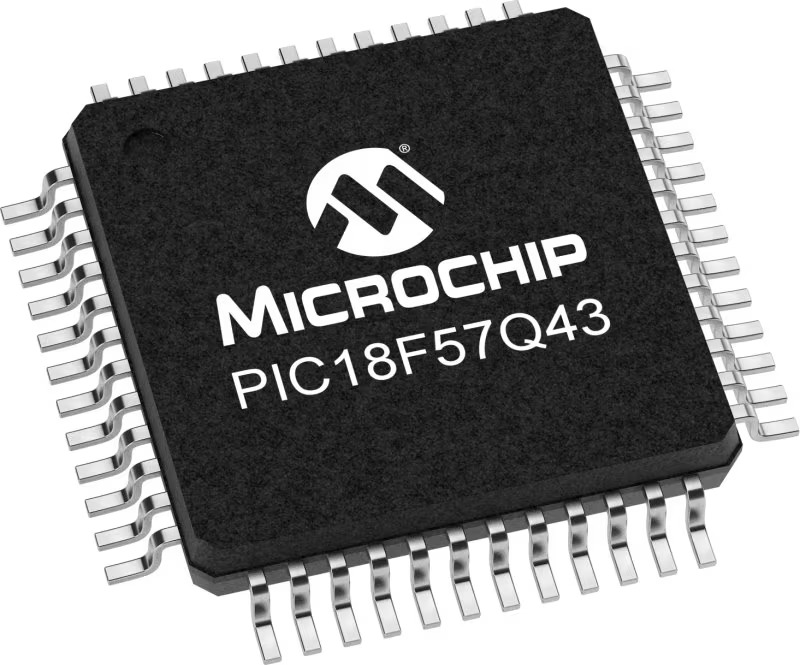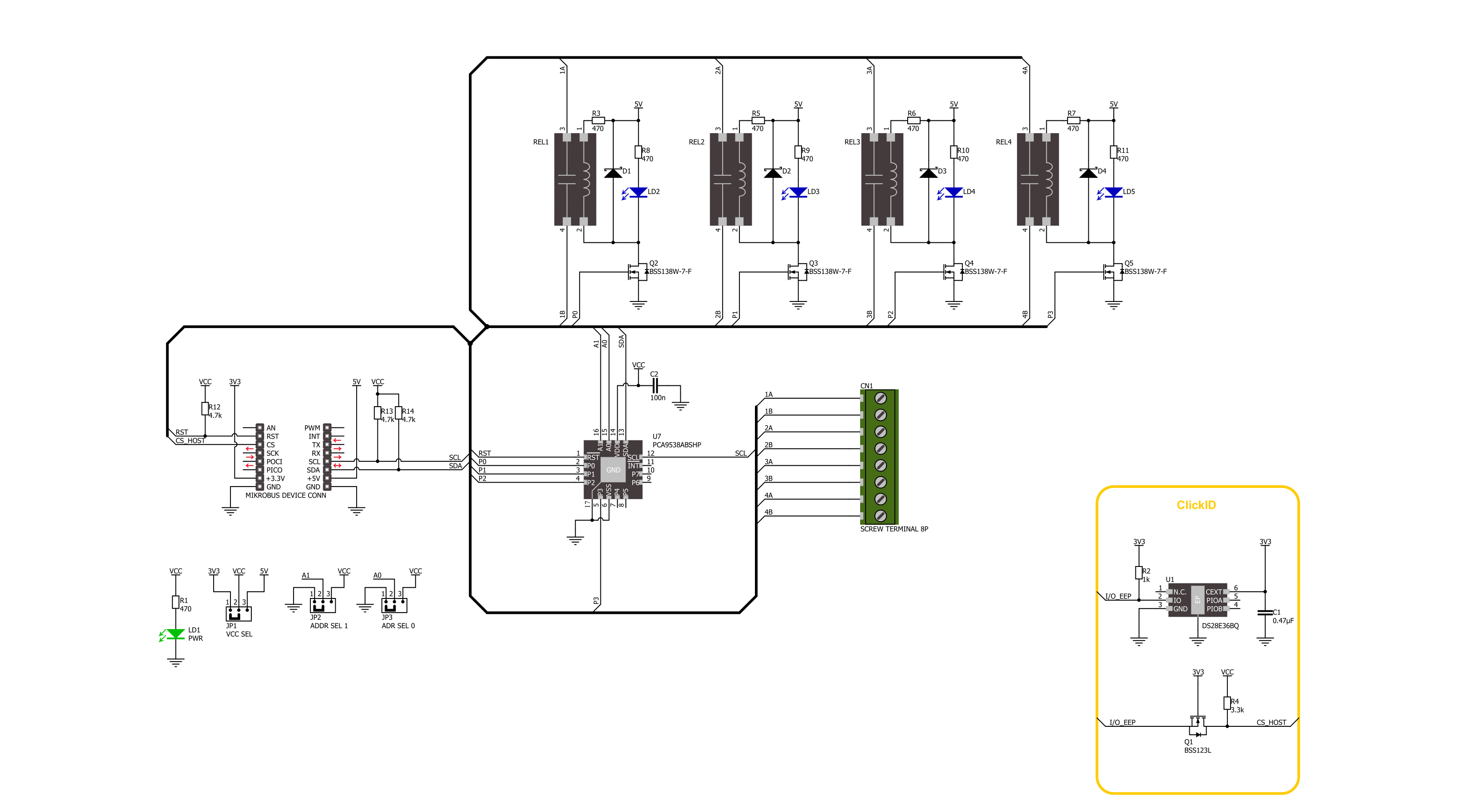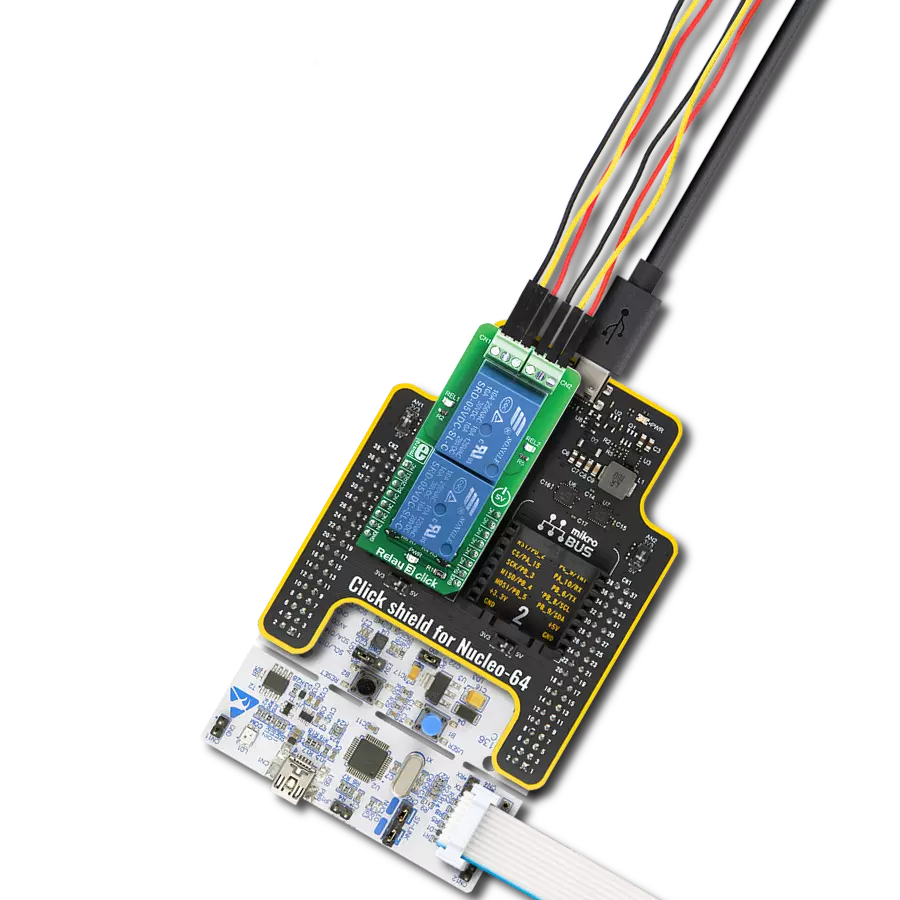Accurately manage four individual loads in automated test equipment, instrumentation, and telecommunications applications.
A
A
Hardware Overview
How does it work?
Relay 6 Click is based on the 9913-05-20TR, a reed relay from Coto Technology, a component known for its ultra-miniature SMD design, standing for the smallest footprint in the market. This Click board™ features four relays, each equipped with four terminals for load connections that are controlled via these relays. Beneath each relay is a blue LED indicator that illuminates to signal when the relay is active, serving as an operational status indicator. This setup provides clear and immediate feedback on the status of each relay, enhancing user control and system monitoring. This Click board™ is ideal for automated test equipment, instrumentation, and telecommunications applications, highlighting high reliability and long
life due to relays hermetically sealed contacts. The 9913-05-20TRs also feature a high insulation resistance of a minimum of 1011Ω and an external magnetic shield. Its electrical specifications include a coil voltage of 5VDC, a coil resistance of 200Ω, a single-pole single-throw normally open (SPST-NO, 1 Form A) contact form, with the contact current rating capped at 250mA and the switching voltage limited to 100VAC and 100VDC. Control and communication between the relays and the host MCU are managed via the PCA9538A port expander, which uses an I2C communication interface. This device supports both Standard and Fast modes, with frequencies up to 400kHz. The PCA9538A's I2C address can be configured
through the ADDR SEL jumpers, allowing flexible integration with various MCU systems. The PCA9538A also uses an RST pin that ensures the registers and I2C-bus state machine remain in their default settings until this pin is set to a HIGH logic state, where the device returns to normal operational status. This Click board™ can operate with either 3.3V or 5V logic voltage levels selected via the VCC SEL jumper. This way, both 3.3V and 5V capable MCUs can use the communication lines properly. Also, this Click board™ comes equipped with a library containing easy-to-use functions and an example code that can be used as a reference for further development.
Features overview
Development board
PIC18F57Q43 Curiosity Nano evaluation kit is a cutting-edge hardware platform designed to evaluate microcontrollers within the PIC18-Q43 family. Central to its design is the inclusion of the powerful PIC18F57Q43 microcontroller (MCU), offering advanced functionalities and robust performance. Key features of this evaluation kit include a yellow user LED and a responsive
mechanical user switch, providing seamless interaction and testing. The provision for a 32.768kHz crystal footprint ensures precision timing capabilities. With an onboard debugger boasting a green power and status LED, programming and debugging become intuitive and efficient. Further enhancing its utility is the Virtual serial port (CDC) and a debug GPIO channel (DGI
GPIO), offering extensive connectivity options. Powered via USB, this kit boasts an adjustable target voltage feature facilitated by the MIC5353 LDO regulator, ensuring stable operation with an output voltage ranging from 1.8V to 5.1V, with a maximum output current of 500mA, subject to ambient temperature and voltage constraints.
Microcontroller Overview
MCU Card / MCU

Architecture
PIC
MCU Memory (KB)
128
Silicon Vendor
Microchip
Pin count
48
RAM (Bytes)
8196
You complete me!
Accessories
Curiosity Nano Base for Click boards is a versatile hardware extension platform created to streamline the integration between Curiosity Nano kits and extension boards, tailored explicitly for the mikroBUS™-standardized Click boards and Xplained Pro extension boards. This innovative base board (shield) offers seamless connectivity and expansion possibilities, simplifying experimentation and development. Key features include USB power compatibility from the Curiosity Nano kit, alongside an alternative external power input option for enhanced flexibility. The onboard Li-Ion/LiPo charger and management circuit ensure smooth operation for battery-powered applications, simplifying usage and management. Moreover, the base incorporates a fixed 3.3V PSU dedicated to target and mikroBUS™ power rails, alongside a fixed 5.0V boost converter catering to 5V power rails of mikroBUS™ sockets, providing stable power delivery for various connected devices.
Used MCU Pins
mikroBUS™ mapper
Take a closer look
Click board™ Schematic

Step by step
Project assembly
Track your results in real time
Application Output
1. Application Output - In Debug mode, the 'Application Output' window enables real-time data monitoring, offering direct insight into execution results. Ensure proper data display by configuring the environment correctly using the provided tutorial.

2. UART Terminal - Use the UART Terminal to monitor data transmission via a USB to UART converter, allowing direct communication between the Click board™ and your development system. Configure the baud rate and other serial settings according to your project's requirements to ensure proper functionality. For step-by-step setup instructions, refer to the provided tutorial.

3. Plot Output - The Plot feature offers a powerful way to visualize real-time sensor data, enabling trend analysis, debugging, and comparison of multiple data points. To set it up correctly, follow the provided tutorial, which includes a step-by-step example of using the Plot feature to display Click board™ readings. To use the Plot feature in your code, use the function: plot(*insert_graph_name*, variable_name);. This is a general format, and it is up to the user to replace 'insert_graph_name' with the actual graph name and 'variable_name' with the parameter to be displayed.

Software Support
Library Description
This library contains API for Relay 6 Click driver.
Key functions:
relay6_reset_port_expander- Relay 6 reset port expander function.relay6_port_expander_write- Relay 6 port expander write register function.relay6_set_relay- Relay 6 set relay state function.
Open Source
Code example
The complete application code and a ready-to-use project are available through the NECTO Studio Package Manager for direct installation in the NECTO Studio. The application code can also be found on the MIKROE GitHub account.
/*!
* @file main.c
* @brief Relay 6 Click example
*
* # Description
* This example demonstrates the use of Relay 6 click board by toggling the relays state.
*
* The demo application is composed of two sections :
*
* ## Application Init
* Initializes the driver and logger.
*
* ## Application Task
* Switches all relays state every second and displays the state on the USB UART.
*
* @author Stefan Ilic
*
*/
#include "board.h"
#include "log.h"
#include "relay6.h"
static relay6_t relay6;
static log_t logger;
void application_init ( void )
{
log_cfg_t log_cfg; /**< Logger config object. */
relay6_cfg_t relay6_cfg; /**< Click config object. */
/**
* Logger initialization.
* Default baud rate: 115200
* Default log level: LOG_LEVEL_DEBUG
* @note If USB_UART_RX and USB_UART_TX
* are defined as HAL_PIN_NC, you will
* need to define them manually for log to work.
* See @b LOG_MAP_USB_UART macro definition for detailed explanation.
*/
LOG_MAP_USB_UART( log_cfg );
log_init( &logger, &log_cfg );
log_info( &logger, " Application Init " );
// Click initialization.
relay6_cfg_setup( &relay6_cfg );
RELAY6_MAP_MIKROBUS( relay6_cfg, MIKROBUS_1 );
if ( I2C_MASTER_ERROR == relay6_init( &relay6, &relay6_cfg ) )
{
log_error( &logger, " Communication init." );
for ( ; ; );
}
if ( RELAY6_ERROR == relay6_default_cfg ( &relay6 ) )
{
log_error( &logger, " Default configuration." );
for ( ; ; );
}
log_info( &logger, " Application Task " );
}
void application_task ( void )
{
uint8_t relay_data;
relay_data = RELAY6_RELAY1_PIN;
log_printf( &logger, " Turning on only Relay 1 \r\n" );
log_printf( &logger, " = = = = = = = = = = = = = \r\n" );
relay6_set_relay( &relay6, relay_data, ~relay_data );
relay_data <<= 1;
Delay_ms( 1000 );
log_printf( &logger, " Turning on only Relay 2 \r\n" );
log_printf( &logger, " = = = = = = = = = = = = = \r\n" );
relay6_set_relay( &relay6, relay_data, ~relay_data );
relay_data <<= 1;
Delay_ms( 1000 );
log_printf( &logger, " Turning on only Relay 3 \r\n" );
log_printf( &logger, " = = = = = = = = = = = = = \r\n" );
relay6_set_relay( &relay6, relay_data, ~relay_data );
relay_data <<= 1;
Delay_ms( 1000 );
log_printf( &logger, " Turning on only Relay 4 \r\n" );
log_printf( &logger, " = = = = = = = = = = = = = \r\n" );
relay6_set_relay( &relay6, relay_data, ~relay_data );
relay_data <<= 1;
Delay_ms( 1000 );
}
void main ( void )
{
application_init( );
for ( ; ; )
{
application_task( );
}
}
// ------------------------------------------------------------------------ END
Additional Support
Resources
Category:Relay



































